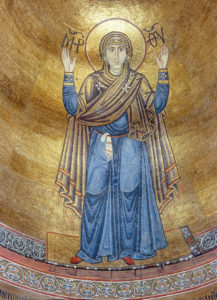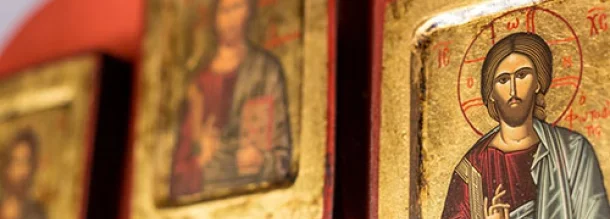
The Virgin Orans: St Sophia’s Cathedral, Kiev, 11th century
Welcome to the Nordic Catholic Church in Germany
Fast facts
- We are an Old Catholic jurisdiction belonging to the Nordic Catholic Church (Union of Scranton), in full canonical communion with the Polish National Catholic Church of America (PNCC).
- We profess the faith of the undivided Church, as summarized in the Orthodox-Old Catholic Agreed Statements, The Road to Unity (1975-1987).
- Like the Orthodox Churches, we are in limited intercommunion with the Roman Catholic Church (in accordance with can. 844 §§ 2-3 CIC).
- Our worship is based on the liturgies of the ancient Christian West, especially the oldest surviving forms of the Roman rite.
- The Nordic Catholic Church in Germany has begun its work in 2012.
Historical sketch
- The Nordic Catholic Church was founded in 1999 in Norway by numerous clergy and laity of the Norwegian (Lutheran) state church, who objected, for theological reasons, to the ordination of women to the presbyterate and episcopate, and had come to embrace the Orthodox Catholic faith of the undivided Church of the first millennium.
- At its inception, the Nordic Catholic Church was formed as an extraterritorial diocese of the Polish National Catholic Church of North America, which belonged to the Union of Utrecht of Old Catholic Churches for more than 96 years (from 1907 to 2003) and indeed was its largest member church. While part of the Union of Utrecht, she remained in communion only with those (few but populous) provinces of the Anglican Communion that had not purported to ordain women to the priesthood.
- The Polish National Catholic Church and thus also the Nordic Catholic Church did not recognize, for theological reasons, the female priests which several of the other member churches of the Union of Utrecht had unilaterally begun to ordain. Since the revised Statute of the Union of Utrecht did not allow for this situation of impaired communion to continue, the Polish National Catholic Church and the Nordic Catholic Church had to separate from the Union of Utrecht in 2003.
- In 2011, the Nordic Catholic Church became autonomous through the election and consecration of a Norwegian bishop, the Most Rev’d Dr Roald Nikolai Flemestad. In the same year, the Polish National Catholic Church and the Nordic Catholic Church joined to found the Union of Scranton as an orthodox alternative to the Union of Utrecht. The Union of Scranton is open to other catholic churches and is in dialogue, for instance, with several jurisdictions of Anglo-Catholic tradition concerning potential membership.
- As of 2018, the Nordic Catholic Church has parishes and missions in Norway, Sweden, Germany, France, Italy, the United Kingdom, and Hungary. The Polish National Catholic Church has parishes in the United States, Canada and Italy, as well as a daughter church in Poland (the Polish Catholic Church, presently still in the Union of Utrecht).
Theology, liturgy, and ecumenical recognition
- The Churches of the Union of Scranton (viz. Polish National Catholic Church and Nordic Catholic Church) are theologically Orthodox: They profess the faith of the Undivided Church as summarized in the Orthodox-Old Catholic Agreed Statements (The Road to Unity, 1975-1987), which constitute their foundational theological document.
- Like the Orthodox Churches, both the Polish National Catholic Church and the Nordic Catholic Church have been in limited intercommunion with the Roman Catholic Church since 2006 (in accordance with can. 844 §§ 2-3 CIC). In particular, the validity of the holy orders and all other sacraments of the Polish National Catholic Church and the Nordic Catholic Church has been recognized by the Roman Catholic Church.
- The Polish National Catholic Church has been a member church of the World Council of Churches since 1948; the Nordic Catholic Church is a member church of the Christian Council of Norway.
- The liturgical practice of the Nordic Catholic Church is based on the tradition of the (early) Western Church.
